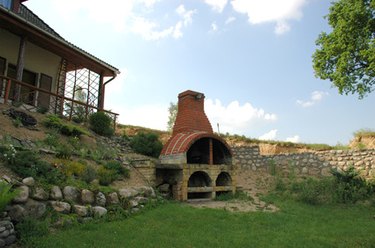
Firebrick lines the interiors of fireplaces, fire pits and brick ovens. It is made from specific materials made to keep heat inside the container it lines while the outside of the container remains relatively cool. This prevents spontaneous fires and scorched walls and floors. Many kinds of firebrick exist, each with its own advantages and disadvantages. If building a fire pit, fireplace, brick oven or other structure requiring heat insulation, make sure to research types of firebrick before starting construction.
Medium Duty
Video of the Day
Forno Bravo recommends this type of firebrick for brick ovens, either indoor or outdoor, for both the arch and flooring. Made of about 35 percent alumina and 50 percent silica, these bricks warm quickly and can insulate temperatures of up to 900 degrees Fahrenheit. Alumina has reflective qualities while silica is an excellent insulator. Combined with the stone brick components, medium duty brick handles a lot of abuse, ensuring that your brick oven will last for years. Good-quality firebricks should have perfectly straight edges and fit against each other with no gaps or pits between them. These bricks come in many shapes and sizes so that your oven can be as large or as small as you like. Good bricks cost about two United States dollars a piece.
Video of the Day
High Duty
These bricks contain over 50 percent alumina, much more than their medium duty cousins. They hold heat for a very long time and can withstand temperatures above 1500 degrees Fahrenheit. These bricks are not recommended for fireplaces or brick ovens; they become far too hot to bake foods properly and present a scorching risk in fireplaces. Forno Bravo recommends this high duty brick for furnaces and incinerators only. They are also very expensive, costing up to twice as much per brick than medium duty pieces.
Clay Brick
Firebrick producers make clay brick in kilns, firing it at high enough temperatures to make it smooth and hard. Though clay firebricks are sturdy, they cannot withstand very high temperatures and are recommended for decoration on the outsides of fireplaces and the chimneys for brick ovens where there is less heat. Clay firebricks also need to be replaced every so often. The constant heating and cooling from their placement causes them to crack and chip. Fortunately, clay bricks cost little more than about 50 United States cents per piece and come in more shapes and decorative varieties because clay so malleable.
Insulation Brick
According to Forno Bravo, insulation brick is not recommended for structures used to heat or bake things. This brick is meant to stop heat from exiting structures and holds little heat itself. Insulation brick does well inside fireplaces, is lightweight and rather inexpensive.